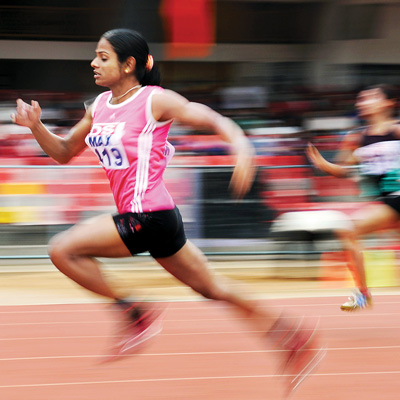
By: Kaitlyn Burns, Staff Writer
For Dutee Chand, the Opening Ceremony for the 2014 Commonwealth Games on July 23, 2014 should have marked one of the proudest moments of her life. Having won a bronze medal for the 200m dash in the 2013 Asian Games, Chand’s future seemed bright as she became the first Indian sprinter to ever partake and place in an international athletic competition.[1] This success generated much excitement among Indian sports fanatics about the positive direction in which Indian women’s track and field appeared to be going. Even Jiji Thomson, the director general of the Sports Authority of India, predicted that Chand would be a “sure shot Olympic medalist” in the 2016 Rio Games.[2] Instead, the day affirmed Chand’s fear that her professional athletic career may come to a premature end because, two weeks before the Commonwealth Games, the Indian national team suddenly dropped her from its roster.[3]
But, why the Indian national team would do something so foolish as to release Chand, a burgeoning track star who had recently made gains that would brand her as “a force to be reckoned with” in the eyes of the global track community and the country’s only chance at winning a women’s track event? The answer is quite simple. The team did not have a choice. According to the regulations set forth by International Olympic Committee (IOC) in 2012, Chand cannot compete in international athletic events because her body’s natural production of testosterone prohibits the global sporting community from recognizing her as a female.[4]
The IOC’s policy regarding the female eligibility to participate in international sporting competitions has created controversy over the years because it pushes some women to do what the sporting community generally discourages: drastically altering one’s body to perform. Under this policy, a female athlete suspected of possessing male anatomical characteristics that would place her at a disproportionate advantage in competition must undergo a gender verification test.[5] To determine if the female athlete has these so called “advantageous” characteristics, a team of medical experts analyze whether the athlete’s testosterone levels rise above an arbitrary threshold that would be comparable to testosterone levels found in men. If this is the case, the IOC labels the athlete as a hyperandrogenous female and bars her from competition on the premise that higher testosterone levels induces better performance and would, thus, be an unfair advantage over fellow competitors. In order for a declared hyperandrogenous female to become eligible to compete, she must either subject herself to hormone therapy or undergo an invasive genital surgical procedure to reduce her testosterone levels and correct her hyperandrogenous condition.[6]
In the past, many female athletes diagnosed with hyperandrogenism have opted to quietly undergo surgery or hormone therapy to be able to compete in global athletic events. However, Chand’s case is unique in that she refuses to alter her body to comply with IOC standards. Instead, she has recently submitted an appeal to the Court of Arbitration for Sport to fight her ban to compete in international track competitions on the grounds that the hyperandrogenism regulation discriminates against female participation in sports.[7]
If the Court of Arbitration for Sport does take this case, the outcome could create drastic changes in the way the IOC and other international sport committees determine athlete eligibility. This is so because both Chand and the IOC/IAAF[8] have strong arguments for either discarding or keeping the hyperandrogenism policy. For example, Chand will articulate the obvious argument that the IOC has not created a policy that excludes male participation in athletic events based on an excessive natural hormone production. Thus, the IOC places an undue burden on female athletes to prove their gender. On the other hand, the IOC/IAAF could argue that this policy is necessary in other to ensure fairness in competition since it is common knowledge that there is a link between elevated testosterone levels and enhanced physical performance.
Regardless of the outcome of the case, providing a clear rule in determining female athletic eligibility would be a benefit to the international athletic community at large. If the Court decides that the female hyperandrogenism regulation is inherently discriminatory against women, then many female athletes who were previously barred from competing at the international level can resume careers in which they have worked hard to attain. This reinstatement would allow for an elevated competition level in women sports because there will be a larger pool of talented female athletes participating in global athletic events. On the other hand, even if the Court decides that the policy does not discriminate against women, at least there would no longer be the lingering question of whether excluding women who exhibit higher than normal levels of testosterone is a fair practice.
[1] Matt Slater, “Sport & Gender: A History of Bad Science and ‘Biological Racism,’” BBC, Oct. 2, 2014, http://www.bbc.com/sport/0/athletics/29446276.
[2] Id.
[3] Id.
[4] IOC Regulations on Female Hyperandrogenism, IOC, June 22, 2012, http://www.olympic.org/Documents/Commissions_PDFfiles/Medical_commission/2012-06-22-IOC-Regulations-on-Female-Hyperandrogenism-eng.pdf
[5] Id.
[6] Patrick Fenichel, Molecular Diagnosis of 5α-Reductase Deficiency in 4 Elite Young Female Athletes Through Hormonal Screening for Hyperandrogenism, 98 The Journal of Clinical Endocrinology & Metabolism (2013), http://press.endocrine.org/doi/full/10.1210/jc.2012-3893?pubCode=cgi&.
[7] Matt Slater, “Sport & Gender: A History of Bad Science and ‘Biological Racism,’” BBC, Oct. 2, 2014, http://www.bbc.com/sport/0/athletics/29446276.
[8] The IAAF is the acronym for the International Association of Athletics Federation. This organization regulates international track and field competitions and has adopted the IOC’s 2012 female hyperandrogenism policy.